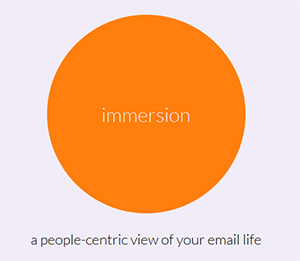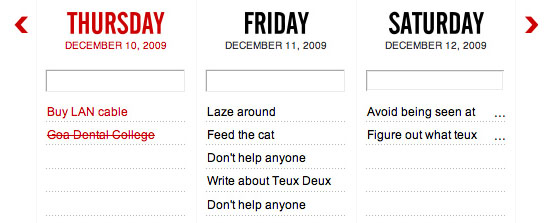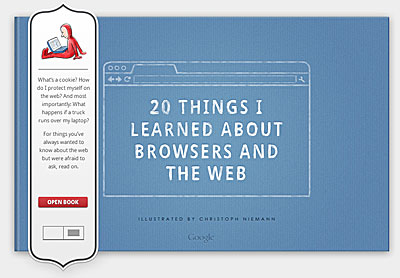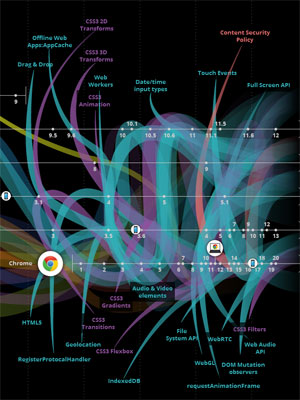 If you and gmail go back a ways, MIT have created a very interesting online tool. Immersion can show you who you communicated with, at what times, who introduced you to whom and how your various contacts are interrelated. Data is displayed as a web of connections, and clicking on the individual nodes/people drills down into their specific statistics. MIT do not scrape your email content, just the from, to, CC and timestamp fields, and that seems to be enough to generate some fascinating information.
If you and gmail go back a ways, MIT have created a very interesting online tool. Immersion can show you who you communicated with, at what times, who introduced you to whom and how your various contacts are interrelated. Data is displayed as a web of connections, and clicking on the individual nodes/people drills down into their specific statistics. MIT do not scrape your email content, just the from, to, CC and timestamp fields, and that seems to be enough to generate some fascinating information.
Cutting Edge Companies
From Fast Company, a compilation of companies intent on 'disrupting' their particular niche. Conspicuously absent from the list are Facebook and Twitter. The Fast Company website is an exemplar of the new trend of sites designed primarily for mobile. One day it will seem odd that an inferior viewing experience (tiny mobile phone screens) is driving the viewing experience for everyone else.
TeuxDeux
 The designer and blogger Tina Roth Eisenberg has come up with a neat little to-do service with a cute name: TeuxDeux. She has pared this free offering back to the absolute essentials of to-do-ness: seven days viewed at once, a list below, order or day of task changed by drag and drop, click twice to finalise a task, click little cross to delete. Future tasks are black, past are grey and present tasks are red. And that's it. It works. One might wish for additional features and email > task capabilities, but any additional features would tend to muddy what is a very clean interface.
The designer and blogger Tina Roth Eisenberg has come up with a neat little to-do service with a cute name: TeuxDeux. She has pared this free offering back to the absolute essentials of to-do-ness: seven days viewed at once, a list below, order or day of task changed by drag and drop, click twice to finalise a task, click little cross to delete. Future tasks are black, past are grey and present tasks are red. And that's it. It works. One might wish for additional features and email > task capabilities, but any additional features would tend to muddy what is a very clean interface.
Be Your Own Newspaper Mogul
There's an American pundit who likes to bang on about the 'hyper-personal news stream' that will supposedly come to dominate the way we consume news. We will select a highly individualised stream of information that closely mirrors our preferences. A taste of this future can be seen with the various news aggregators. Paper.li can take Twitter, Facebook or Google+ feeds and turn them into quite an attractive simulation of a newspaper. A business can build a collection of feeds likely to be of interest to its clients, including their own tweets or Facebook posts. A pro version of the service also allows a company to add their brand/logo to the newsletter, currently $9 per month.
Book, Meet Internet...
 A neat little primer on the contemporary Internet, comissioned by Google Chrome, illustrated by Christoph Nieman and (oddly enough) designed to look like a printed book (old metaphors die very hard). Learn about TCP/IP, web standards, the cloud, html5, plugins, extensions and more, all in straightforward, non-technical language.
A neat little primer on the contemporary Internet, comissioned by Google Chrome, illustrated by Christoph Nieman and (oddly enough) designed to look like a printed book (old metaphors die very hard). Learn about TCP/IP, web standards, the cloud, html5, plugins, extensions and more, all in straightforward, non-technical language.
What the Web is Made Of
 Even casual users of the Internet will have noticed its constant evolution. Sites are vastly more sophisticated, attractive and responsive than they once were. Usability has evolved into a fine art and ecommerce has finally come of age. If you are interested in the underlying machinery that makes the modern Web hum, this website will be of interest. Displayed as a timeline, the site charts the arrival and growth of various protocols, security initiatives, programming languages and browsers. The early days of the Web are revealed in all their primitive glory and the sophistication of the current moment (with much more to come).
Even casual users of the Internet will have noticed its constant evolution. Sites are vastly more sophisticated, attractive and responsive than they once were. Usability has evolved into a fine art and ecommerce has finally come of age. If you are interested in the underlying machinery that makes the modern Web hum, this website will be of interest. Displayed as a timeline, the site charts the arrival and growth of various protocols, security initiatives, programming languages and browsers. The early days of the Web are revealed in all their primitive glory and the sophistication of the current moment (with much more to come).
Principles for User-Friendly Web Services
A creditable attempt by the UK government to enshrine a list of simple principles for constructing user-friendly web-based services. The ten items listed are:
The website then goes on to enlarge on each point, giving concrete examples. The site authors promise to continually refine the list of principles.
Photoshop Plugin is Just Their Type
A giant in the world of quality type, the FontShop can now tout its wares from inside Photoshop. Install their plugin, and you can preview any of the thousands of typefaces on offer. If you like what you see, click through to their online store, buy the typeface and start using it. Many are the ways a designer can be parted from their money.
